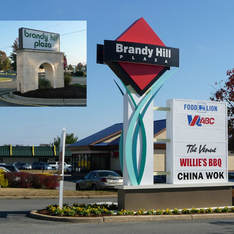 Your entrance sign is your property's best form of advertising. Your entrance sign is your property's best form of advertising.
“You never get a second chance to make a good first impression.” – Abraham Lincoln
Okay, so maybe it wasn’t the nation’s 16th president who originally said that, but he certainly could have. It’s a famous quote, not attributable to any one individual, that applies to our personal lives, professional reputations, and for purposes of this blog, the entrance signs we build for our clients. No matter what type of property you manage – shopping center, hospital, office park, or mixed-use – the entrance sign is the first impression you will make to potential visitors. I’m often surprised by how property managers and owners treat these prominent landmarks as afterthoughts. The fact is that an entrance sign can be the one feature that draws people in – or drives them away. When visitors arrive, it is the entrance sign that tells them just what kind of place they’ve come to. Therefore, the big question you must ask when considering your entrance sign – whether it’s a pylon or monument – is, “What kind of first impression do I hope to make?” Here are four keys to putting your best foot forward.
1 Comment
Check out our progress on two pylons (50 ft. and 35 ft.) for Kimco at their Dania Pointe mixed-use development in Florida. Let us know what you think. Top Property Managers Use This Tool to Keep Their Centers Looking Their Best Mismatched colors and cheap banners hung too low hurt this center's curb appeal. Mismatched colors and cheap banners hung too low hurt this center's curb appeal.
You work hard to create a great customer experience. The right tenants, well-maintained landscaping, and an attractive entrance pylon sign all help you create a great first impression. Curb appeal matters, right? Well there’s another important factor that you shouldn’t overlook and it may be the most critical if you want your retail center to look professional and attractive. It’s your tenants’ signage.
I can almost hear you now saying, “How can I control my tenants’ signs?” Well you can and you absolutely should. Not only will signage guidelines help you maintain the “look” you want for your center but they will also help prevent future disagreements with your tenants (and between your tenants). These guidelines are called “tenant signage criteria.” The criteria document should be made as an exhibit in the tenant’s lease so that it is clear from the outset what the criteria are -- and also that the criteria are enforceable as part of the lease. Effective tenant signage criteria anticipate problems before they happen, and explain the landlord’s perspective on all things signs with straightforward, clear-cut language. Your guidelines may address things like size, placement, materials, colors, and lighting. Here are five keys to developing effective tenant signage criteria.
Retail centers in Buckhead, a wealthy Atlanta enclave, compete for some of the world's top brands as well as for local businesses that create world-class shopping and dining experiences. Buckhead Court shopping center, managed by our client Regency Centers, has seen a dramatic transformation in recent years to not only remain competitive in this environment but to become a destination of choice for local shoppers.
A great tenant mix has been a major factor in drawing customers back to the center. This property now features a signature restaurant, a luxury home goods boutique and several providers of spa and wellness services. The center and its tenants have also been working together on marketing and event planning to make sure that locals get the word about their offerings. Even with all this work, something still wasn't right. The center's old pylon sign wasn't creating a positive first impression. 
The commercial sign market has experienced a watershed shift in the use of one of a sign’s crucial components. Fluorescent bulbs long were the favored technology for giving signs their glow, but LED bulbs have emerged in recent years as a preferred choice for many sign-makers and their customers.
Newly fabricated signs now often are installed with LED bulbs, including most signs designed and fabricated by Ad Vice Studios. In addition, shopping center operators and others increasingly are weighing the value of retrofitting their existing signs with new LED bulbs. Ad Vice, for instance, has seen a surge in retrofit requests. A LED retrofit comes at an upfront cost. The ballast, trays and electronics must be replaced, along with the bulbs. However, LED bulbs provide an array of key advantages that often make a retrofit an attractive option that is well worth the investment. If you are wondering whether a retrofit is right for you, here are some of the critical benefits to consider. Get our Sign Pricing Guide - Real projects, real pricing Whether you’re developing a new property or renovating the signs at an existing one, the cost will be an important consideration. How much should you budget for new signs? What can I get for the amount that I’ve already budgeted? Our Sign Pricing Guide was created to help answer these and other questions related to custom sign development. Pricing information for pylons, monuments, directories and way finding signs Factors that determine sign cost Alternative materials that may save you moneySign cost vs. other advertising options Download your copy now!  Your friends at Ad Vice Studios just want to remind you to use this week to make sure your light timers and digital message boards are ready for the time change on Sunday, March 11 at 2 am. That's easier to do than to reset the clock on the stove! More daylight means more visitors will see your signs, so be sure to make them shine. You may also want to replace any burned out bulbs and freshen up the landscaping around your signs. All this talk about Daylight Savings Time made us curious about why we do this anyway. Here's what we found. Daylight saving time 2018: 7 myths and facts about changing the clock (bigthink.com)
Protect your company’s investment with these five ideas for making a great first impression. 
Contrary to what you may read, the retail industry is not dying, but it has become harder than ever to get customers to put down their phones and computers and pay a visit to our locations.
People want to shop in places that look inviting, fun, safe, and have an appealing tenant mix of both quality stores and, if the location merits it, solid dining options. Therefore, it is crucial to maintain the appearance of your property from storefront to the street. When properties are neglected, they can contribute to neighborhood decline, lower property values, and even crime. When shoppers are given a welcoming, enjoyable environment, they stick around longer – and hopefully spend more. Depending on the age of your shopping center, it may be time to consider upgrading the appearance. Here are five ways to do so.
You’ve got a lot of competition, online and offline. Create new reasons for your customers to visit your center.

In a world that becomes more digitally oriented every day, operating a brick-and-mortar retail location can seem daunting. There’s no denying that online shopping has increased in recent years, but according to a recent Pew Research Center survey, 64 percent of Americans still prefer to buy from a physical store, and RetailNext pegs 94 percent of all retail sales stemming from a store.
Still, with the majority of Americans believing they can find a better deal online, it’s important as a property manager to get creative in finding ways to get new feet onto your property. You can do that by creating engaging experiences that shoppers can’t get on the web. So if that guy you paid to dance on the side of the road spinning a sign scared away as many people as he brought in, here are a few other ideas to try.
Do your homework or risk major delays to your sign approval. 
When I started in the commercial signage business 27 years ago, we could walk into a city or county permitting office and, 15 minutes later, leave with an approved sign permit.
These days, if you choose to wait, you’ll be sitting in that same office for about five weeks on average. I love everything about the signage business, but after nearly three decades, the most challenging part remains the permitting process. Regulations have become more challenging, establishing overall height, setbacks from the street and nearby structures, square footage allowances for text, distance between signs, and the number of signs that a property is allowed to have. Rules and regulations – which vary depending on whether it's a commercial, industrial, or residential zone – are done in the name of keeping a pleasant aesthetic to streetscapes and skylines (although beauty is in the eye of the beholder) and, perhaps more nobly, ensures displays don’t impede right of way and keeps people safe (which we support). In an otherwise two-party, commercial transaction between sign designer/installer and property, the involvement of government bureaucracy can quickly slow down business. And sometimes, these stringent regulations can kill a project altogether. Here are eight tips I’ve learned over the years to get through it as fast as possible and keep your project on track. |
Ad Vice StudiosDavid Goodwin is the president of Ad Vice Studios, a Richmond, Va-based marketing services company. David has built his career and his business collaborating with property managers, developers and architects to transform commercial properties into attractive destinations with unique brands and customer experiences. Archives
August 2018
Categories
All
|


 RSS Feed
RSS Feed